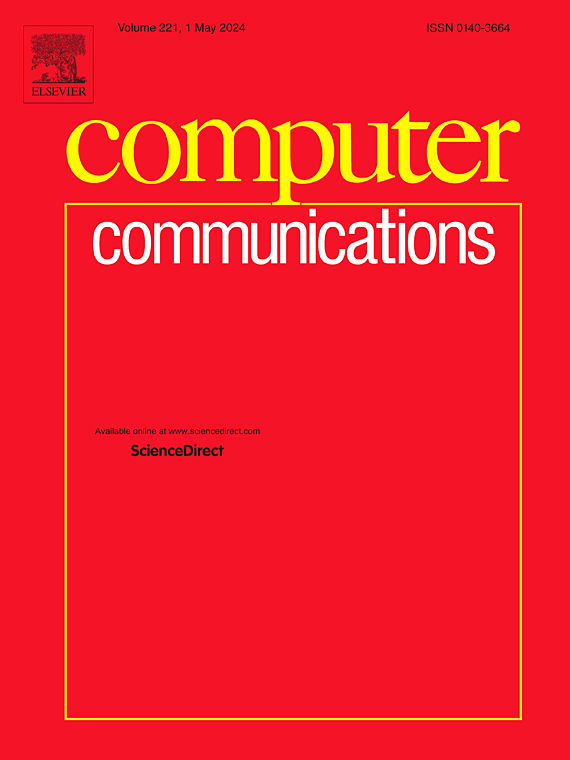Disjoint end-to-end walks for Service Function Chain provisioning and protection
IF 4.3
3区 计算机科学
Q1 COMPUTER SCIENCE, INFORMATION SYSTEMS
引用次数: 0
Abstract
Service Function Chains (SFCs) enable traffic to flow through Virtual Network Functions (VNFs) deployed on physical servers to deliver network services. While SDN (Software Defined Network)/NFV (Network Function Virtualization) provides flexible network management, ensuring service continuity remains challenging and requires robust protection mechanisms.
Network failures can be addressed through local or end-to-end protection approaches. Local protection relies on multiple detours, potentially protecting against failures of the same components, which leads to complex management and multiple detour activations for single failures. End-to-end protection ensures service continuity through two end-to-end disjoint SFC provisioning paths, significantly reducing both route maintenance overhead and resource allocations.
This paper addresses the challenge of finding two end-to-end disjoint paths for SFC provisioning and protection. We first model the problem using ILP and prove its -completeness, even in over-resourced networks where single SFC provisioning is polynomial-time solvable. To address this complexity, we propose a novel three-step heuristic that enhances protection through transient route computation that is intended to “leave room” and facilitate disjoint provisioning identification. Recomputation of the transient route is established to enhance the resource allocation while improving the protection efficiency. Our extensive simulations demonstrate significant improvements over conventional approaches, showing notable enhancement in both protection efficiency and SFC path quality without incurring additional costs.
不相交的端到端行走,用于业务功能链的发放和保护
sfc (Service Function Chains)是指业务功能链,通过物理服务器上部署的VNFs (Virtual Network Functions)来提供网络服务。虽然SDN(软件定义网络)/NFV(网络功能虚拟化)提供了灵活的网络管理,但确保业务连续性仍然是一个挑战,需要强大的保护机制。网络故障可以通过本地或端到端保护方法来解决。本地保护依赖于多个弯路,潜在地防止相同组件的故障,这导致复杂的管理和针对单个故障的多个弯路激活。端到端保护通过两条端到端不相连的SFC发放路径保证业务连续性,大大减少了路由维护开销和资源分配。本文解决了为SFC提供和保护找到两个端到端不相交路径的挑战。我们首先使用ILP对问题建模,并证明了它的np完备性,即使在资源过剩的网络中,单个SFC配置是多项式时间可解的。为了解决这种复杂性,我们提出了一种新的三步启发式方法,通过瞬态路由计算增强保护,旨在“留出空间”并促进不连接供应识别。建立暂态路由的重新计算,在提高保护效率的同时加强资源分配。我们的大量模拟表明,与传统方法相比,该方法有了显著的改进,在不产生额外成本的情况下,保护效率和SFC路径质量都得到了显著提高。
本文章由计算机程序翻译,如有差异,请以英文原文为准。
求助全文
约1分钟内获得全文
求助全文
来源期刊

Computer Communications
工程技术-电信学
CiteScore
14.10
自引率
5.00%
发文量
397
审稿时长
66 days
期刊介绍:
Computer and Communications networks are key infrastructures of the information society with high socio-economic value as they contribute to the correct operations of many critical services (from healthcare to finance and transportation). Internet is the core of today''s computer-communication infrastructures. This has transformed the Internet, from a robust network for data transfer between computers, to a global, content-rich, communication and information system where contents are increasingly generated by the users, and distributed according to human social relations. Next-generation network technologies, architectures and protocols are therefore required to overcome the limitations of the legacy Internet and add new capabilities and services. The future Internet should be ubiquitous, secure, resilient, and closer to human communication paradigms.
Computer Communications is a peer-reviewed international journal that publishes high-quality scientific articles (both theory and practice) and survey papers covering all aspects of future computer communication networks (on all layers, except the physical layer), with a special attention to the evolution of the Internet architecture, protocols, services, and applications.
 求助内容:
求助内容: 应助结果提醒方式:
应助结果提醒方式:


